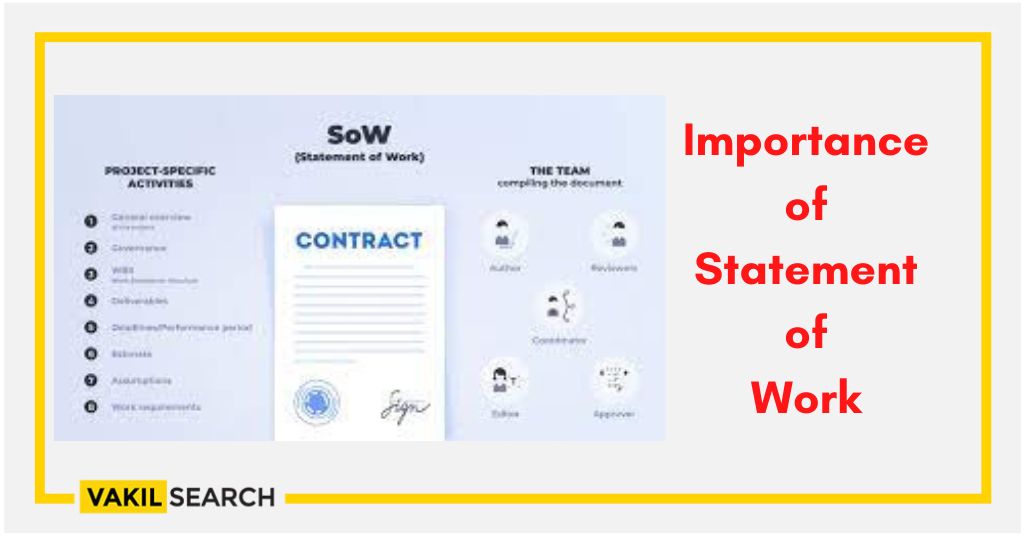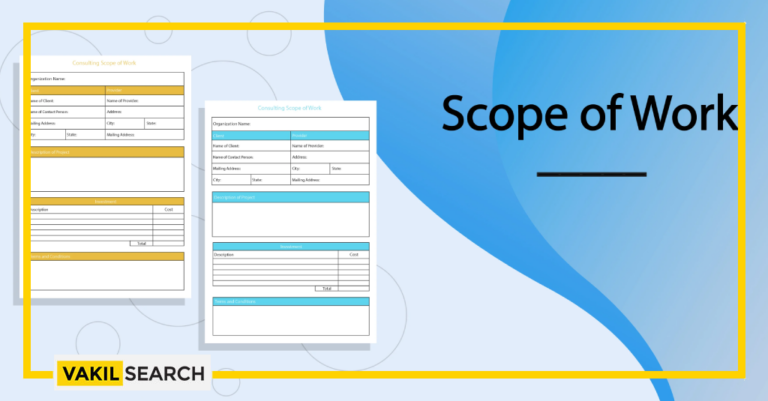The Statement of Work (SOW) is a vital document in project management that outlines the scope, deliverables, timelines, and expectations of a project. We help define the project requirements, provide guidance, manage expectations, and identify roles and responsibilities. Vakilsearch can assist in ensuring a robust SOW for your projects.
Introduction
A Statement of Work (SOW) is a crucial document in various industries, including government contracts, construction, information technology, and consulting. It serves as a formal agreement between two parties, typically a client and a vendor, outlining the scope, objectives, deliverables, and responsibilities for a particular project or service. In India, the use of SOW has gained significant importance due to its role in establishing clear expectations, reducing misunderstandings, and ensuring successful project outcomes. This article explores the definition, significance, writing process, key elements, and related documents of the Statement of Work in the Indian context.
What is a Statement of Work?
A Statement of Work (SOW) is a detailed and comprehensive document that defines the specific tasks, requirements, deliverables, and timelines of a project or service. It outlines the responsibilities of both parties involved and serves as a roadmap for the successful completion of the project. The SOW acts as a binding contract that establishes a mutual understanding of the project’s scope and objectives.
Why is SOW Important?
The importance of a Statement of Work in India lies in its ability to provide clarity, alignment, and risk mitigation during the execution of a project. Some key reasons for its significance include:
- Clarity and Scope Definition: The SOW clearly defines the project’s scope, objectives, and deliverables, leaving no room for ambiguity or misinterpretation. It ensures that both parties have a shared understanding of what needs to be accomplished
- Risk Management: A well-drafted SOW includes risk identification and mitigation strategies, which helps in minimising potential issues and disputes during project execution
- Resource Allocation: The SOW aids in determining the necessary resources, such as personnel, equipment, and budget, required for the project, ensuring efficient allocation and utilisation
- Budget and Cost Management: It outlines the project’s budget and cost structure, enabling better financial planning and cost control
- Legal Protection: The SOW serves as a legally binding agreement, providing legal protection to both the client and the vendor in case of disputes or breaches of contract.
What are the Benefits of Managing SOWs?
Managing Statements of Work (SOWs) offers several advantages, including:
- Clarity: SOWs define project scope, objectives, and deliverables clearly, reducing misunderstandings
- Cost Control: Effective SOW management helps control project costs and prevents scope creep
- Quality Assurance: It ensures work meets quality standards and compliance requirements
- Risk Mitigation: Managing SOWs helps identify and address risks early in the project
- Vendor Performance: It enables the evaluation and management of vendor performance
- Legal Protection: A well-managed SOW can serve as a legally binding document, protecting all parties
- Stakeholder Alignment: It aligns project expectations among stakeholders
- Efficiency: Efficient management saves time and resources throughout a project’s lifecycle.
Can SOWs be Managed Through an MSP/VMS?
Yes, SOWs can be managed through Managed Service Providers (MSPs) and Vendor Management Systems (VMS). MSPs and VMS provide tools and expertise to streamline SOW management, including vendor selection, compliance, performance tracking and cost control.
What is the Difference between SOW and Services Procurement?
A Statement of Work (SOW) is a specific document that outlines project details, including objectives, deliverables and tasks. Services procurement, on the other hand, is a broader process encompassing sourcing and acquisition of services, which may involve issuing SOWs as part of that process.
Statement of Work vs. Scope of Work
A Statement of Work (SOW) and a Scope of Work (SoW) are often used interchangeably, but they can have subtle differences. The SOW typically focuses on project details, objectives and deliverables. Whereas the SoW emphasises a broader perspective spanning project goals, limitations and constraints.
Statement of Work Example
An example of an SOW might include project-specific details, such as project goals, milestones, timelines, deliverables, acceptance criteria and roles and responsibilities.
How to Write a Statement of Work?
Writing an effective Statement of Work involves the following steps
- Project Overview: Begin by providing a brief introduction to the project, including its purpose and objectives
- Scope of Work: Clearly define the scope of the project, including what is included and excluded from the deliverables
- Timeline and Milestones: Set realistic timelines for the project and identify key milestones for progress tracking
- Roles and Responsibilities: Clearly outline the roles and responsibilities of each party involved in the project
- Resource Requirements: Specify the resources required, such as manpower, equipment, materials, and budget
- Performance Standards: Define the quality and performance standards expected for the deliverables
- Change Management: Include procedures for handling changes or modifications to the project scope
- Risk Management: Identify potential risks and outline risk mitigation strategies
- Acceptance Criteria: Clearly state the criteria for the client’s acceptance of the deliverables
- Terms and Conditions: Include any relevant terms and conditions governing the project.
Key Elements of a Procurement Statement of Work
In the context of procurement, a Statement of Work should include the following key elements:
- Background and Objectives: Provide an overview of the procurement project and its objectives
- Scope of Work: Clearly define the goods or services to be procured and the project’s scope
- Technical Specifications: Include detailed technical specifications and requirements for the procured items or services
- Delivery Schedule: Specify the timeline for delivery and completion of the project
- Payment Terms: Outline the payment terms and conditions for the procurement
- Quality Standards: Define the expected quality standards for the procured goods or services
- Inspection and Acceptance: Include procedures for inspection and acceptance of the procured items
- Warranties and Guarantees: Specify any warranties or guarantees provided by the vendor.
SOW Related Documents
Several documents are related to the Statement of Work and are essential for effective project management:
- Request for Proposal (RFP): The RFP is a document that requests vendors to submit proposals for providing goods or services. The SOW is often a part of the RFP
- Contract Agreement: Once the SOW is finalised and accepted, it becomes a part of the overall contract agreement between the client and the vendor
- Work Breakdown Structure (WBS): The WBS is a hierarchical representation of the project’s tasks and deliverables derived from the SOW
- Project Schedule: The project schedule is developed based on the timelines and milestones defined in the SOW.
Common Types of Statements of Work
Design/Detail SOW: This type of SOW provides detailed specifications and requirements for the design and development of a product or service. It includes technical details, design specifications, and other relevant information.
Level of Effort/Time and Materials/Unit Rate SOW: This type of SOW defines the level of effort, time, and materials required for the project. It outlines the hourly rates, materials costs, and other related expenses.
Performance-Based SOW: This type of Statement of Work (SOW) focuses on the desired outcomes or performance metrics of the project. It outlines the expected results or performance goals and the criteria for measuring success.
Legal Review Importance in SOW
In order to protect the interests of all parties involved and to ensure compliance with existing laws and regulations, it is essential to have a lawyer analyse the SOW. Potential legal issues are avoided, risks are reduced, and each party’s rights and obligations are protected.
Conclusion
The Statement of Work (SOW) plays a crucial role in project management and business relationships by clearly outlining the scope, objectives, and expectations of a project. It serves as a foundational document that helps mitigate misunderstandings, manage expectations, and establish a common understanding between stakeholders. The importance of a well-defined SOW extends across various industries and project types, promoting project success and effective collaboration.
Additionally, understanding the different types of SOWs, such as narrative, performance-based, and deliverable-based, allows organisations to tailor their approach to specific project requirements, enhancing clarity and accountability throughout the project lifecycle. Emphasising the significance of a comprehensive SOW ensures smoother project execution, better risk management, and increased overall project success. For more information regarding the same, get in touch with Vakilsearch today. We will resolve all the issues and help you in drafting a foolproof of SOW.
FAQs
1. Can an SOW be legally binding?
Yes, an SOW can be legally binding if it meets the necessary legal requirements and the parties involved intend for it to be a binding contract.
2. Are there industry-specific variations of SOWs?
Yes, different industries have different variations of SOWs tailored to their specific needs.
3. Why is clarity crucial in drafting an SOW?
Clarity is vital to ensure that all parties understand project expectations, deliverables and responsibilities as it reduces misunderstandings and disputes.
4. What types of projects typically require an SOW?
SOWs are commonly used in complex projects, including IT development, construction, consulting and research, where defining project scope and expectations is critical.
What is the importance of SOW in procurement?
It's a formal document designed to guide vendors or contractors on how project work should be executed.
Why is the SOW important in contract management?
An SOW, also called a Statement of Work, serves as a contractual document detailing project objectives and deliverables. Its purpose is to ensure clarity regarding deadlines, project scope, and expectations, fostering alignment between clients and vendors to achieve shared project goals.
What is SOW productivity?
SOW productivity refers to the efficiency and output of a Statement of Work (SOW) within a given timeframe. It measures the effectiveness of resources, time management, and quality of deliverables outlined in the SOW.
What is SOW production?
SOW production involves creating and refining a Statement of Work (SOW) document, outlining project objectives, deliverables, timelines, and resource allocation. Effective SOW production ensures clarity, alignment, and successful execution of project tasks and goals.
Also Read,










